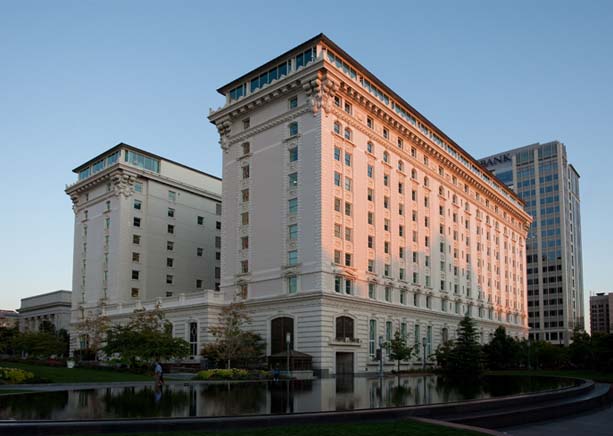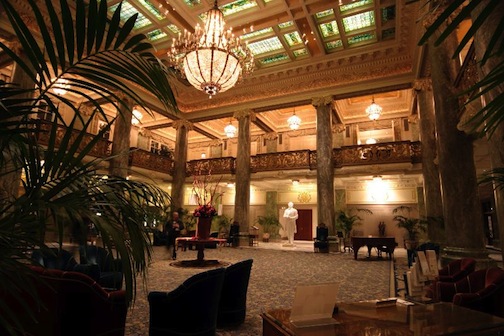Difference between revisions of "Joseph Smith Memorial Building"
| Line 1: | Line 1: | ||
[[Image:JSMB.jpg|300px|thumb|left]] | [[Image:JSMB.jpg|300px|thumb|left]] | ||
| − | [[image:Joseph_Smith_Memorial_Building_Lobby.jpg|300px|thumb| | + | [[image:Joseph_Smith_Memorial_Building_Lobby.jpg|300px|thumb|left]] |
The '''Joseph Smith Memorial Building''' is named in honour of [[Joseph Smith, Jr.]]. It is located on the corner of Main Street and South Temple in Salt Lake City. Previously a hotel, it is now an administrative building. | The '''Joseph Smith Memorial Building''' is named in honour of [[Joseph Smith, Jr.]]. It is located on the corner of Main Street and South Temple in Salt Lake City. Previously a hotel, it is now an administrative building. | ||
Revision as of 13:36, 24 June 2020
The Joseph Smith Memorial Building is named in honour of Joseph Smith, Jr.. It is located on the corner of Main Street and South Temple in Salt Lake City. Previously a hotel, it is now an administrative building.
History of the location and building
The corner of Main Street and South Temple has long been important in Utah history. Prior to construction of the Hotel Utah in 1909-11, The Church of Jesus Christ of Latter-day Saints' general tithing office, bishop's storehouse, and the Deseret News printing plant were located on the site.
Work on the Second Renaissance Revival–style hotel, designed by the Los Angeles architectural firm of Parkinson and Bergstrom, began in June 1909. Two years later, on June 9, 1911, the Hotel Utah opened for business. While the Church was the primary stockholder, many Mormon and non-Mormon community and business leaders also purchased stock in the effort to provide the city with a first-class hotel. For seventy-six years the Hotel Utah hosted local citizens, world travelers, celebrities, and every president of the United States from William Taft to Ronald Reagan.
"The largest and finest bar in the West was built in the basement of the Hotel" to help pay off a $2M construction loan. The financing was secured by Presiding Bishop Charles W. Nibley, from New York financier Charles Baruch. But the scheme obviously required the sale of hard liquor. When informed of building a bar, “President Joseph F. Smith went through the ceiling; which was it to be, the word of Wisdom or fiscal soundness?" In the end, President Smith capitulated. (Hugh Nibley, Approaching Zion, Deseret Book, 1989, p. 470).
The ten-story building has a concrete and steel structure and is covered with white glazed terra cotta and brick. Various additions and remodelings have occurred throughout the years, including a substantial expansion to the north and modifications to the roof-top dining facilities.
The hotel, complete with restaurants and over 468,000 square feet, was beginning to pose problematic. In 1987, the leadership of the Mormon Church faced a decision about the future of the hotel.
- We didn’t know what to do with this building,” noted President Gordon B. Hinckley at the dedication of the Joseph Smith Memorial Building as he reflected on the Church’s decision to close the structure as a hotel. The building was seventy-five years old, did not meet the present-day seismic codes, yet community and state historical organizations clamored for the building’s preservation.
- It was a problem,” President Hinckley continued. “We talked about it on a number of occasions. Should we refurbish it as a hotel? Should we raze it and make this a park? We were faced with other pressures. The Church is growing tremendously across the world. Existing facilities have become inadequate because of this tremendous growth.
- It was determined that we would do two things: preserve it as a very precious thing in this community and at the same time use the building to meet the growing needs of a growing church.[1]
The building ceased operations as a hotel in August 1987. After three years of extensive renovations to remodel and adapt the building for both community and church functions, the Joseph Smith Memorial Building was dedicated on June 27, 1993, which marked the 149th anniversary of the martyrdom of the Prophet Joseph Smith.
- The Brethren were aware that various buildings at Church headquarters had come and gone over the years. Today several structures remain in remembrance of Brigham Young—such as the Lion and Beehive houses. But there was nothing to memorialize the Prophet Joseph Smith.
- After the First Presidency discussed the matter, President Hinckley and President Monson met with the Quorum of the Twelve in their weekly meeting in the Salt Lake Temple. There it was proposed that the name of the building be the Joseph Smith Memorial Building.
- They were all agreeable with it,” said President Hinckley. “I think the Lord wanted this building named the Joseph Smith Memorial Building.”[2]
The original Beehive Tower continues to sit atop the building, flanked on all four sides by an eagle perched on a U. S. shield. The origin of the beehive as a symbol hearkens back to the Book of Mormon, where the word deseret means “honeybee.” Early settlers of Utah called it Deseret and the beehive stood as a symbol of united industry and self-reliance. In 1847, the beehive was adopted as an official emblem and is the centerpiece of the state flag and the state seal.
Current use
The church now uses this building with the following features:
- A large, historical ornately decorated multi-story lobby, featuring a large Carrera-marble statue of Joseph Smith, Jr., and an enormous crystal chandelier. Live classical music is often performed here as background.
- The Family Search Center, where the public can use the provided computers, materials, and assistance to do family history research and genealogy. The newly opened Family Discovery Center, located on the main floor of the Joseph Smith Memorial Building, offers visitors an immersive experience into their own family history. According to the LDS Church News, "Upon entry, a visitor is given a tablet computer on which he enters his FamilySearch login. This becomes the visitor’s personal guide as he or she takes it to any of the individual stations."[3] Visits can be scheduled at Familysearch.org. Walk-in guests are allowed based on availability
- The 500-seat Legacy Theater, where the public can enjoy inspirational regularly scheduled free showings of various church-produced movies. It is showing Meet the Mormons currently.
- Two fine-dining restaurants, "The Roof" and "The Garden" on the top floor, provide wonderful views of downtown Salt Lake City. The floor also offers public viewing areas.
- The new Nauvoo Café is located on the southwest corner and provides soups, sandwiches, salads, pot pies, and a beautiful view of the new Main Street Plaza and Temple Square.
- Interior levels of the building are devoted to ongoing work on various Church software projects, supporting the worldwide Family History centers, and various other activities.
- Many restored rooms on the ground level—including The Empire Room, The Bonneville Room, and The Nauvoo Room (formerly The Pioneer Room), and on the ninth and tenth floors, can be rented out for wedding receptions, dinners, and other public uses.
- A chapel, a Relief Society room, classrooms, stake offices, and a library provided space for nearby LDS wards and a stake.
- The two-level underground parking area that was built in the 1940s was replaced with a four-level parking area.

